Chen Lin
Efficient and Universal Neural-Network Decoder for Stabilizer-Based Quantum Error Correction
Feb 27, 2025Abstract:Quantum error correction is crucial for large-scale quantum computing, but the absence of efficient decoders for new codes like quantum low-density parity-check (QLDPC) codes has hindered progress. Here we introduce a universal decoder based on linear attention sequence modeling and graph neural network that operates directly on any stabilizer code's graph structure. Our numerical experiments demonstrate that this decoder outperforms specialized algorithms in both accuracy and speed across diverse stabilizer codes, including surface codes, color codes, and QLDPC codes. The decoder maintains linear time scaling with syndrome measurements and requires no structural modifications between different codes. For the Bivariate Bicycle code with distance 12, our approach achieves a 39.4% lower logical error rate than previous best decoders while requiring only ~1% of the decoding time. These results provide a practical, universal solution for quantum error correction, eliminating the need for code-specific decoders.
Scalable Equilibrium Sampling with Sequential Boltzmann Generators
Feb 25, 2025Abstract:Scalable sampling of molecular states in thermodynamic equilibrium is a long-standing challenge in statistical physics. Boltzmann generators tackle this problem by pairing powerful normalizing flows with importance sampling to obtain statistically independent samples under the target distribution. In this paper, we extend the Boltzmann generator framework and introduce Sequential Boltzmann generators (SBG) with two key improvements. The first is a highly efficient non-equivariant Transformer-based normalizing flow operating directly on all-atom Cartesian coordinates. In contrast to equivariant continuous flows of prior methods, we leverage exactly invertible non-equivariant architectures which are highly efficient both during sample generation and likelihood computation. As a result, this unlocks more sophisticated inference strategies beyond standard importance sampling. More precisely, as a second key improvement we perform inference-time scaling of flow samples using annealed Langevin dynamics which transports samples toward the target distribution leading to lower variance (annealed) importance weights which enable higher fidelity resampling with sequential Monte Carlo. SBG achieves state-of-the-art performance w.r.t. all metrics on molecular systems, demonstrating the first equilibrium sampling in Cartesian coordinates of tri, tetra, and hexapeptides that were so far intractable for prior Boltzmann generators.
Implicit Neural Representations for Chemical Reaction Paths
Feb 20, 2025Abstract:We show that neural networks can be optimized to represent minimum energy paths as continuous functions, offering a flexible alternative to discrete path-search methods like Nudged Elastic Band (NEB). Our approach parameterizes reaction paths with a network trained on a loss function that discards tangential energy gradients and enables instant estimation of the transition state. We first validate the method on two-dimensional potentials and then demonstrate its advantages over NEB on challenging atomistic systems where (i) poor initial guesses yield unphysical paths, (ii) multiple competing paths exist, or (iii) the reaction follows a complex multi-step mechanism. Results highlight the versatility of the method -- for instance, a simple adjustment to the sampling strategy during optimization can help escape local-minimum solutions. Finally, in a low-dimensional setting, we demonstrate that a single neural network can learn from existing paths and generalize to unseen systems, showing promise for a universal reaction path representation.
DeepThink: Aligning Language Models with Domain-Specific User Intents
Feb 08, 2025Abstract:Supervised fine-tuning with synthesized instructions has been a common practice for adapting LLMs to domain-specific QA tasks. However, the synthesized instructions deviate from real user questions and expected answers. This study proposes a novel framework called DeepThink to generate high-quality instructions. DeepThink first generates a few seed questions to mimic actual user questions, simulates conversations to uncover the hidden user needs, and refines the answer by conversational contexts and the retrieved documents for more comprehensive answers. Experiments demonstrate that DeepThink achieves an average performance improvement of 7.92% compared to a GPT-4-turbo+RAG-based assistant on the real user test set in the advertising domain across dimensions such as relevance, completeness, clarity, accuracy, and actionability.
Sigma: Differential Rescaling of Query, Key and Value for Efficient Language Models
Jan 23, 2025



Abstract:We introduce Sigma, an efficient large language model specialized for the system domain, empowered by a novel architecture including DiffQKV attention, and pre-trained on our meticulously collected system domain data. DiffQKV attention significantly enhances the inference efficiency of Sigma by optimizing the Query (Q), Key (K), and Value (V) components in the attention mechanism differentially, based on their varying impacts on the model performance and efficiency indicators. Specifically, we (1) conduct extensive experiments that demonstrate the model's varying sensitivity to the compression of K and V components, leading to the development of differentially compressed KV, and (2) propose augmented Q to expand the Q head dimension, which enhances the model's representation capacity with minimal impacts on the inference speed. Rigorous theoretical and empirical analyses reveal that DiffQKV attention significantly enhances efficiency, achieving up to a 33.36% improvement in inference speed over the conventional grouped-query attention (GQA) in long-context scenarios. We pre-train Sigma on 6T tokens from various sources, including 19.5B system domain data that we carefully collect and 1T tokens of synthesized and rewritten data. In general domains, Sigma achieves comparable performance to other state-of-arts models. In the system domain, we introduce the first comprehensive benchmark AIMicius, where Sigma demonstrates remarkable performance across all tasks, significantly outperforming GPT-4 with an absolute improvement up to 52.5%.
Revolutionizing Database Q&A with Large Language Models: Comprehensive Benchmark and Evaluation
Sep 05, 2024Abstract:The development of Large Language Models (LLMs) has revolutionized Q&A across various industries, including the database domain. However, there is still a lack of a comprehensive benchmark to evaluate the capabilities of different LLMs and their modular components in database Q&A. To this end, we introduce DQA, the first comprehensive database Q&A benchmark. DQA features an innovative LLM-based method for automating the generation, cleaning, and rewriting of database Q&A, resulting in over 240,000 Q&A pairs in English and Chinese. These Q&A pairs cover nearly all aspects of database knowledge, including database manuals, database blogs, and database tools. This inclusion allows for additional assessment of LLMs' Retrieval-Augmented Generation (RAG) and Tool Invocation Generation (TIG) capabilities in the database Q&A task. Furthermore, we propose a comprehensive LLM-based database Q&A testbed on DQA. This testbed is highly modular and scalable, with both basic and advanced components like Question Classification Routing (QCR), RAG, TIG, and Prompt Template Engineering (PTE). Besides, DQA provides a complete evaluation pipeline, featuring diverse metrics and a standardized evaluation process to ensure comprehensiveness, accuracy, and fairness. We use DQA to evaluate the database Q&A capabilities under the proposed testbed comprehensively. The evaluation reveals findings like (i) the strengths and limitations of nine different LLM-based Q&A bots and (ii) the performance impact and potential improvements of various service components (e.g., QCR, RAG, TIG). We hope our benchmark and findings will better guide the future development of LLM-based database Q&A research.
Improving Multi-modal Recommender Systems by Denoising and Aligning Multi-modal Content and User Feedback
Jun 18, 2024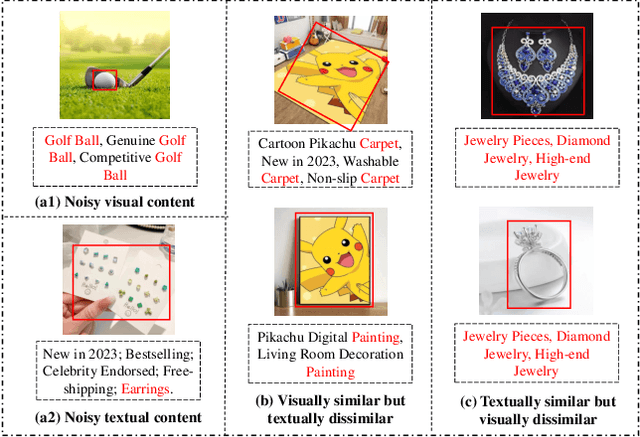
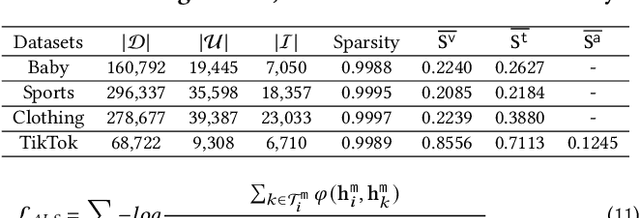
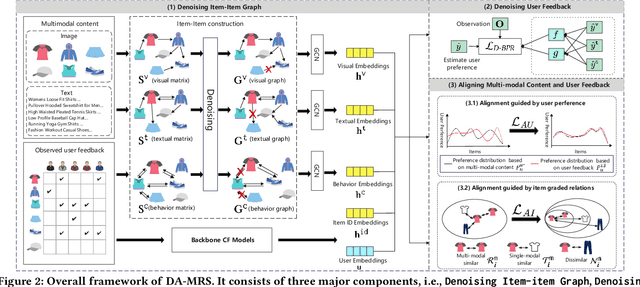
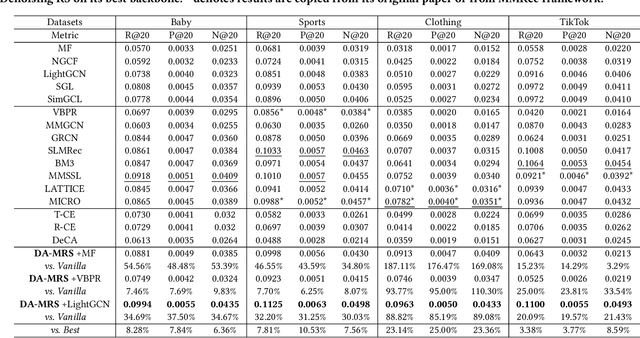
Abstract:Multi-modal recommender systems (MRSs) are pivotal in diverse online web platforms and have garnered considerable attention in recent years. However, previous studies overlook the challenges of (1) noisy multi-modal content, (2) noisy user feedback, and (3) aligning multi-modal content with user feedback. In order to tackle these challenges, we propose Denoising and Aligning Multi-modal Recommender System (DA-MRS). To mitigate multi-modal noise, DA-MRS first constructs item-item graphs determined by consistent content similarity across modalities. To denoise user feedback, DA-MRS associates the probability of observed feedback with multi-modal content and devises a denoised BPR loss. Furthermore, DA-MRS implements Alignment guided by User preference to enhance task-specific item representation and Alignment guided by graded Item relations to provide finer-grained alignment. Extensive experiments verify that DA-MRS is a plug-and-play framework and achieves significant and consistent improvements across various datasets, backbone models, and noisy scenarios.
DocReLM: Mastering Document Retrieval with Language Model
May 19, 2024Abstract:With over 200 million published academic documents and millions of new documents being written each year, academic researchers face the challenge of searching for information within this vast corpus. However, existing retrieval systems struggle to understand the semantics and domain knowledge present in academic papers. In this work, we demonstrate that by utilizing large language models, a document retrieval system can achieve advanced semantic understanding capabilities, significantly outperforming existing systems. Our approach involves training the retriever and reranker using domain-specific data generated by large language models. Additionally, we utilize large language models to identify candidates from the references of retrieved papers to further enhance the performance. We use a test set annotated by academic researchers in the fields of quantum physics and computer vision to evaluate our system's performance. The results show that DocReLM achieves a Top 10 accuracy of 44.12% in computer vision, compared to Google Scholar's 15.69%, and an increase to 36.21% in quantum physics, while that of Google Scholar is 12.96%.
Lumina-T2X: Transforming Text into Any Modality, Resolution, and Duration via Flow-based Large Diffusion Transformers
May 09, 2024

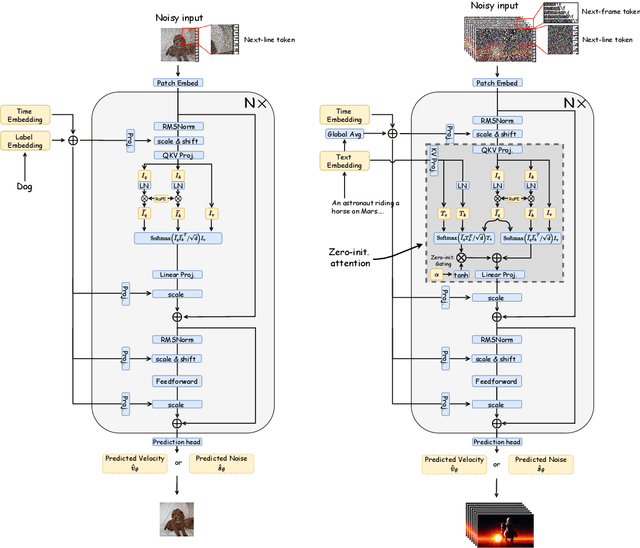
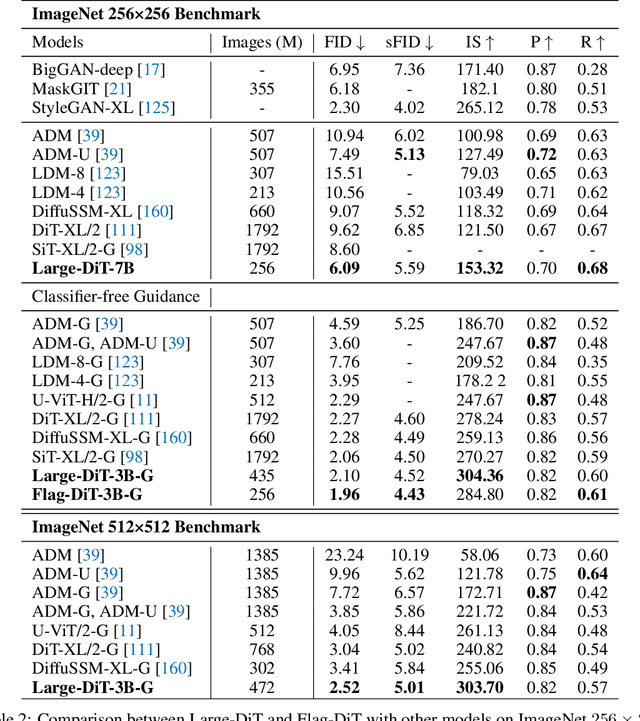
Abstract:Sora unveils the potential of scaling Diffusion Transformer for generating photorealistic images and videos at arbitrary resolutions, aspect ratios, and durations, yet it still lacks sufficient implementation details. In this technical report, we introduce the Lumina-T2X family - a series of Flow-based Large Diffusion Transformers (Flag-DiT) equipped with zero-initialized attention, as a unified framework designed to transform noise into images, videos, multi-view 3D objects, and audio clips conditioned on text instructions. By tokenizing the latent spatial-temporal space and incorporating learnable placeholders such as [nextline] and [nextframe] tokens, Lumina-T2X seamlessly unifies the representations of different modalities across various spatial-temporal resolutions. This unified approach enables training within a single framework for different modalities and allows for flexible generation of multimodal data at any resolution, aspect ratio, and length during inference. Advanced techniques like RoPE, RMSNorm, and flow matching enhance the stability, flexibility, and scalability of Flag-DiT, enabling models of Lumina-T2X to scale up to 7 billion parameters and extend the context window to 128K tokens. This is particularly beneficial for creating ultra-high-definition images with our Lumina-T2I model and long 720p videos with our Lumina-T2V model. Remarkably, Lumina-T2I, powered by a 5-billion-parameter Flag-DiT, requires only 35% of the training computational costs of a 600-million-parameter naive DiT. Our further comprehensive analysis underscores Lumina-T2X's preliminary capability in resolution extrapolation, high-resolution editing, generating consistent 3D views, and synthesizing videos with seamless transitions. We expect that the open-sourcing of Lumina-T2X will further foster creativity, transparency, and diversity in the generative AI community.
Rho-1: Not All Tokens Are What You Need
Apr 11, 2024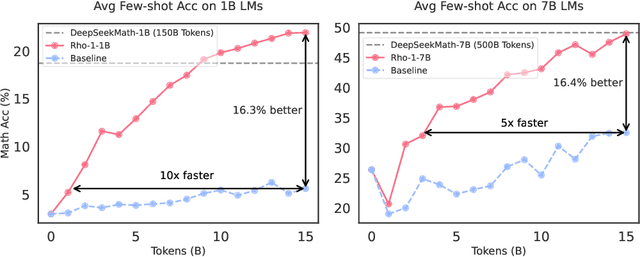
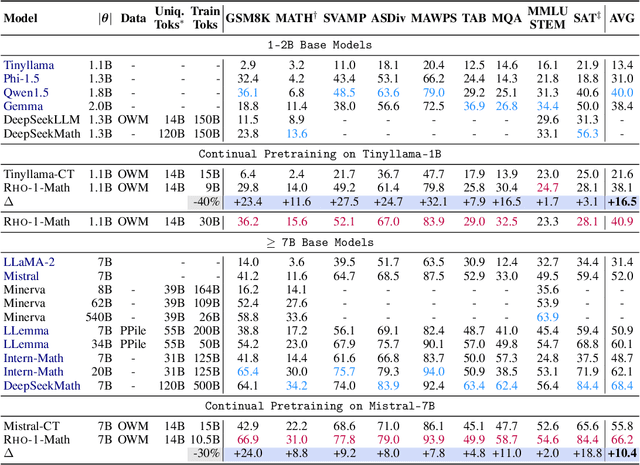
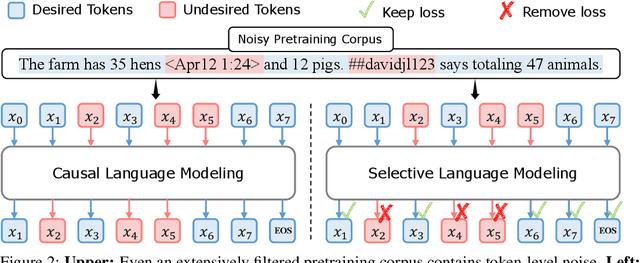
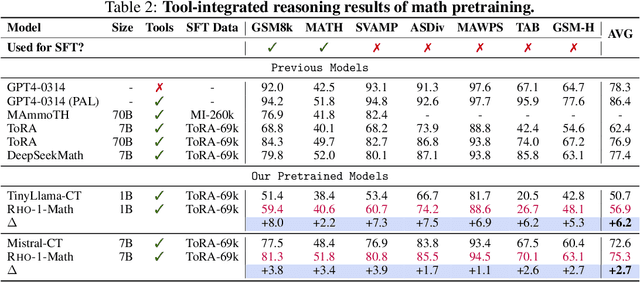
Abstract:Previous language model pre-training methods have uniformly applied a next-token prediction loss to all training tokens. Challenging this norm, we posit that "Not all tokens in a corpus are equally important for language model training". Our initial analysis delves into token-level training dynamics of language model, revealing distinct loss patterns for different tokens. Leveraging these insights, we introduce a new language model called Rho-1. Unlike traditional LMs that learn to predict every next token in a corpus, Rho-1 employs Selective Language Modeling (SLM), which selectively trains on useful tokens that aligned with the desired distribution. This approach involves scoring pretraining tokens using a reference model, and then training the language model with a focused loss on tokens with higher excess loss. When continual pretraining on 15B OpenWebMath corpus, Rho-1 yields an absolute improvement in few-shot accuracy of up to 30% in 9 math tasks. After fine-tuning, Rho-1-1B and 7B achieved state-of-the-art results of 40.6% and 51.8% on MATH dataset, respectively - matching DeepSeekMath with only 3% of the pretraining tokens. Furthermore, when pretraining on 80B general tokens, Rho-1 achieves 6.8% average enhancement across 15 diverse tasks, increasing both efficiency and performance of the language model pre-training.
 Add to Chrome
Add to Chrome Add to Firefox
Add to Firefox Add to Edge
Add to Edge